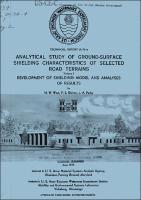Please use this identifier to cite or link to this item:
https://hdl.handle.net/11681/32486Full metadata record
| DC Field | Value | Language |
|---|---|---|
| dc.contributor.author | West, Harold W. | - |
| dc.contributor.author | Doiron, Phillip L. | - |
| dc.contributor.author | Parks, Judith A. | - |
| dc.contributor.author | Mobility and Environmental Systems Laboratory (U.S.) | - |
| dc.date.accessioned | 2019-04-05T16:20:47Z | - |
| dc.date.available | 2019-04-05T16:20:47Z | - |
| dc.date.issued | 1974-06 | - |
| dc.identifier.govdoc | Technical Report M-74-4 Volume 1 | - |
| dc.identifier.uri | https://hdl.handle.net/11681/32486 | - |
| dc.description | Technical Report | en_US |
| dc.description.abstract | The mathematical model presented herein allows the user to determine the amount of shielding from munition bursts offered by the ground surface to targets (vehicles, personnel, etc.) on and moving along roads or in cross-country terrains. In the shielding model it is assumed that fragments and projectiles travel in straight-line trajectories; therefore, the amount of shielding offered by the ground surface to a target is calculated along the optical paths between the burst point and selected points on the target. The shielding values given by the model are maximum values. Shielding characteristics in terms or probability of shielding for a point(s) on a target, or in terms of average shielding for a one-dimensional target of a specified height, can be obtained. The model variables include target height, number of target height intervals, locations of five target positions, elevations of six munition height of bursts (HOB), and eight horizontal target-to-HOB ranges. Shielding results are provided for six road sites near Vicksburg, Miss., selected to be representative of a wide range of road configurations known to occur in various geographical regions. The ground-surface shielding results obtained for the six road sites show that shielding of a one-dimension a vertical target is significantly affected by both distance (or range) and burst height, and that shielding does not change appreciably for the different target positions that were evaluated along the center line of the road. However, since five target locations were in relatively uniform areas, it is believed that target location would have a significant effect on shielding on those roads that contain closely spaced cuts and fills or the six sites for which shielding calculations were made, site 6 contained the greatest amount of shielding; this amount increased with increasing range and decreased only slightly with increasing burst height. At sites l through 5, the shielding of the target varied between 0 and 25 percent for the different ranges and burst heights equal to and greater than 100 cm. For a burst height of 0 cm (i.e. ground burst), the shielding of the target varied between 10 and 55 percent for the different ranges. Appendix A describes the general procedures used in the acquisition and recording of on-site three-dimensional topographic data and presents the topographic dAta that were collected at the six road sites. Appendix B describes the interpolation procedure used in determining a fine grid of equally spaced discrete elevation (i.e. 2-m grid points) from a set of randomly located (field measured) elevation points. Appendix C presents examples of the tabular output of the shielding model. Volume II (published in limited quantity) contains the total tabular output of the shielding model. | en_US |
| dc.description.sponsorship | Sponsored by U.S. Army Materiel Systems Analysis Agency, Aberdeen Proving Ground, Maryland | en_US |
| dc.description.tableofcontents | FOREWORD-iii CONVERSION FACTORS, METRIC TO BRITISH UNITS OF MEASUREMENT-vii SUMMARY-ix PART I: INTRODUCTION-1 Objectives and Scope-1 Approach-1 PART II: DEVELOPMENT OF THE GROUND-SURFACE SHIELDING MODEL-4 General Description -4 Model Variables -6 PART III: GENERAL TERRAIN DESCRIPTIONS, TOPOGRAPHIC SURVEY PROCEDURES, AND GENERATION AND ANALYSIS OF ELEVATION DATA ARRAYS -9 General Terrain Descriptions -9 Topographic Survey Procedures -11 Generation and Analysis of Gridded Elevation Data Arrays-13 PART IV: GROUND-SURFACE SHIELDING CHARACTERISTICS-16 Presentation of Ground-Surface Shielding Results-16 Analyses of Ground-Surface Shielding Results-17 Supplemental Considerations -18 Inputs to Materiel Programs -20 PART V: CONCLUSIONS AND RECOMMENDATIONS -21 Conclusions-22 Reconunendations FIGURES 1-54 APPENDIX A: TABLES Al-A8 GENERAL PROCEDURES FOR THE ACQUISITION AND RECORDING OF ON-SITE THREE-DIMENSIONAL TOPOGRAPHIC DATA APPENDIX B: LINEAR INTERPOLATION PROCEDURE USED IN DETERMINING ELEVATION GRID ARRAYS Four-Variable Interpolation Procedure Three-Variable Interpolation Procedure APPENDIX C: EX.AMPLE OF OUTPUT OF SHIELDING MODEL FIGURES Cl-C4 | - |
| dc.format.extent | 208 pgs / 8.854Mb | - |
| dc.format.medium | PDF/A | - |
| dc.language.iso | en_US | en_US |
| dc.publisher | U.S. Army Engineer Waterways Experiment Station | en_US |
| dc.relation.ispartofseries | Technical Report (U.S. Army Engineer Waterways Experiment Station);no. M-74-4 | - |
| dc.rights | Approved for public release; distribution is unlimited | - |
| dc.source | The ERDC Library created this digital resource using one or more of the following: Zeta TS-0995, Zeutcehl OS 12000, HP HD Pro 42-in. map scanner, Epson flatbed | - |
| dc.subject | Defensive (Military science)--Mathematical models | en_US |
| dc.subject | Offensive (Military science)--Mathematical models | en_US |
| dc.subject | Siege warfare--Mathematical models | en_US |
| dc.subject | Shooting, Military--Mathematical models | en_US |
| dc.title | Analytical Study of Ground-Surface Shielding Characteristics of Selected Road Terrains. Volume 1, Development of Shielding Model and Analyses of Results | en_US |
| dc.type | Report | - |
| Appears in Collections: | Technical Report | |
Files in This Item:
| File | Description | Size | Format | |
|---|---|---|---|---|
| Technical Report M-74-4 Vol 1.pdf | 9.07 MB | Adobe PDF |  View/Open |